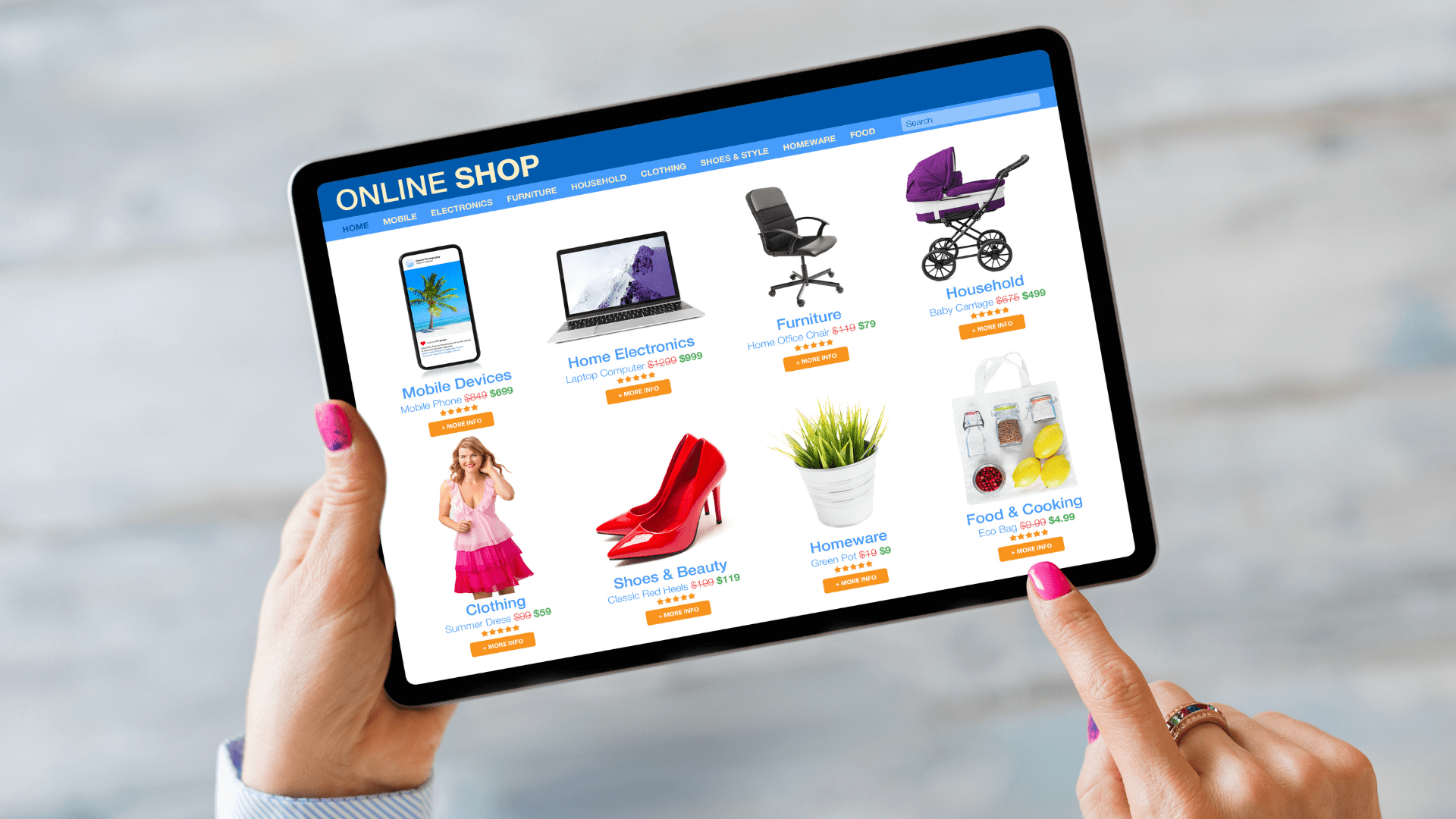62% of global e-commerce revenue is predicted to originate from mobile platforms by 2027. So many companies are jumping into the lucrative Ecommerce App Development In the Bangladesh sector because of this noteworthy trend.
Investing in Ecommerce App Development In Bangladesh can help you increase revenue and conversion rates, reach a larger audience, and enhance consumer engagement through personalized experiences.

Ecommerce App Development: What Is It?
Developing mobile e-commerce applications allows companies to advertise and sell goods and services online.
Research and planning on the market are usually the first steps in developing an ecommerce application. Subsequently, the product design phase ensues, succeeded by development, thorough testing, and deployment.
Companies can either assemble an internal team of app developers to handle the work or contract this mobile app development to a specialist ecommerce app development company (like Distillery).
What Kinds of Ecommerce App Development Are There?
E-commerce applications have completely changed how we purchase and sell because they support a wide range of market demands and company structures.
You can select from the following categories of e-commerce software based on your type of business:
- Predicted Transaction Participants
Business-to-business (B2B) e-commerce apps: These programs make business-to-business transactions easier. For example, Amazon Business and Quill offer bulk purchasing and pricing tailored to businesses’ unique requirements.
Business-to-consumer (B2C) e-commerce applications are for one-on-one transactions between companies and clients. Popular examples are Domino’s for food delivery and Amazon for retail goods.
Applications for mobile devices that facilitate business-to-business (C2B) e-commerce allow customers to present goods and services to companies. While Clutch enables companies to locate and hire consultants or agencies, GitHub facilitates developer cooperation.
Apps for consumer-to-consumer (C2C) e-commerce: These apps, like eBay for a large selection of products and OLX for secondhand goods, enable customer transactions.
- Depending on the functionality or business model
Ecommerce Aggregator applications: Similar to Grubhub and Zomato for food delivery services, these smartphone applications aggregate offers from multiple suppliers under one roof.
Ecommerce App Development for Ticketing and Booking: These apps focus on bookings and reservations, including Booking.com and Expedia.
E-commerce apps for auctions and bidding: Sites like eBay and Sotheby’s let customers bid on anything from common goods to rare antiquities.
- Additional
- Apps for social e-commerce (like Pinterest)
- E-commerce apps that require a subscription (like Birchbox)
- E-commerce apps for dropshipping (like Oberlo)
- E-commerce apps with flash sales and deals (like Groupon)
We’ll now dive into the newest trends and insights influencing the ecommerce app development environment in 2024 to help you stay ahead of the game.
Trends in the Top Ecommerce App Development Market for 2024 and Beyond
The worldwide Ecommerce App Development market is anticipated to grow from $3.59 trillion in 2024 to $6.9 trillion in 2024 and $8.15 trillion by the end of 2026.
With a staggering 64.1% market share, China dominates the global e-commerce business. The US comes in second, about 10% of all e-commerce transactions globally.
Major competitors in this fiercely competitive sector include Walmart, Alibaba Group, Amazon, and others.
In 2024 and beyond, keep an eye out for these trends:
Big Data
Uses vast data sets to analyze consumer behavior and preferences to improve the customer experience.
Experience with Augmented Reality (AR) and Virtual Reality (VR)
AR and VR technologies turn shopping into an immersive environment.
One-Click Purchase
Allows transactions to be completed with just one click, simplifying the purchasing procedure.
Artificial Intelligence (AI) Chatbots
Round-the-clock chatbots with artificial intelligence that offer immediate customer support and tailored shopping assistance.
Social Media Commerce
Enables direct purchases from social feeds by seamlessly integrating shopping elements into social media platforms.
Voice assistants
Using voice recognition technology, they provide hands-free browsing and purchasing choices.
Wearable app integration increases accessibility and convenience by enabling e-commerce interactions from wearable devices.
Geofencing
Uses location-based marketing and offers to target potential customers in particular areas.
Implementing cutting-edge cybersecurity methods to safeguard consumer data—such as requiring biometric authentication for app access—builds confidence.
The goal of sustainability and eco-friendly practices is to lessen the influence on the environment by using sustainable methods in the procurement, packaging, and delivery of products.
Types of Ecommerce App Development
Mobile commerce, or m-commerce, has been propelled to a platform continuously advancing enterprises thanks to smartphones used for buying. The success mantra has opened up new avenues for enterprises to generate revenue. Thanks to mobile apps, customers now have constant contact. They can now place orders at any moment by accessing their preferred stores.
The programs that will assist the operations vary depending on the different models that the firms use. The apps are distinguished by their features and functionalities, created to satisfy certain corporate aims and objectives.
- Business-to-Business (B2B)
- Business-to-Consumer (B2C)
- Consumer-to-Consumer (C2C)
- Consumer-to-Business (C2B)
Ecommerce App Development for Business-to-Business (B2B)
This category includes applications that can facilitate business transactions through their interface. Mobile channels facilitate wide-scale transactions for significant quantities of exchange by offering the ability to exchange goods and services.
Alibaba, Amazon Business, and Quill are examples of businesses that sell to merchants who then sell to consumers. Thus, the goods sold here may be used as raw materials or finished goods in later sectors.
Ecommerce App Development for Business-to-Consumer (B2C)
The product’s end user will be at one end of the applications created to support a B2C model, and the corporation will be at the other. Sales are placed directly via the application channel. E-commerce apps like Amazon and Domino are two instances of this.
With these applications, customers may directly access any product that a company sells, whereas with several brands, retailers may have to restrict the number of stocks and variety available.
Ecommerce App Development for Consumer-to-Business (C2B)
Businesses can also purchase content, design, and technological assets unique to a specialty domain. C2B platforms such as GitHub and Clutch make building such commercial contacts and showcasing expertise possible make building such commercial contacts and knowledge possible.
Companies suggest strengthening the practice of sharing valuable talent through these channels and creating distinctive characteristics on top of such purchases.
Ecommerce App Development for C2C (Consumer-to-Consumer)
A C2C model operates via a mobile app when customers trade their goods, offers, or services amongst themselves without the involvement of businesses or companies.
Applications that let users sell their goods to other people who are similar to them, like OLX and eBay, support these kinds of sales and purchases by facilitating communication amongst a larger user base, such as the community.
Purchasing and Scheduling Ecommerce App Development
Mobile ticketing e-commerce applications allow you to purchase movie and concert tickets.
These kinds of eCommerce app development In Bangladesh enable ticket booking for various events. Tickets for parties, vacations, and performances can also be reserved.
It’s a convenient and speedy way to meet new people. Contributing to such applications does not require a large foundation.

Principal Advantages of Ecommerce App Development for Your Company
The development of e-commerce websites is essential for firms to advance. However, e-commerce and mobile applications are becoming increasingly common.
According to researchers, nine out of ten users prefer to use their phones to make online purchases. Learn more about the growth statistics of mobile app usage.
In other words, shoppers have more choices when purchasing on their phones when shopping online. Nevertheless, the value of mobile and web e-commerce applications cannot be overstated.
Mobility
One of the great things about mobile commerce solutions is the ability to move your store from town to town. However, in practice, this is not feasible.
Mobile apps allow you to refer to anything from one user to another. A trade can be made with a mobile app’s straightforward share button.
Thus, you can have limitless mobility with Ecommerce App Development In Bangladesh.
Individualized Marketing
Businesses used to be unable to reach every potential customer.
With the advancement of Ecommerce App Development, reaching every single client is now feasible and much simpler.
Additionally, the development of digital eCommerce applications can enable one-on-one client targeting.
Quick and Secure Payment
E-commerce platforms with integrated capabilities will enable you to make payments more quickly and securely. It resembles an in-app purchasing mechanism.
If you have bills to pay off, m-banking software and the boom of digital banking would be excellent choices.
Create an app with Ecommerce App Development that will satisfy your users by facilitating quick purchases and simple refunds.
Time of Loading
Ten years ago, Internet consumers were prepared to wait up to eight (8) seconds for a web page to load. However, current data indicates that users would abandon a website after waiting three seconds. See Reasons for Website Users to Leave.
These days, fifty percent (50%) of visitors to your e-commerce website may depart if it takes at most three (3) seconds to load. They probably will only look at a single product after leaving.
Tailored Content
One of the most important components of any e-commerce software is personalized content. These options help you organize and mold your buying preferences.
In addition, you can store important features like past orders in the program in the program. You, too, can supply the foundation for customized products. eCommerce application development services provide state-of-the-art methods for integrating customized content into your application.
In-Person Access
The sophisticated Ecommerce App Development businesses have generated numerous apps with rudimentary functionality, one of which is offline access.
Offline access allows you to control several aspects of e-commerce apps, such as comparing products and prices.
It will please you to know that certain new programs also support full-power performance.
Easy-to-use Interface
Regarding case loading, mobile applications are superior to responsive websites. This is so that consumers have a better experience and they can load more quickly.
Customers who have a bad first impression will not return to your store. Thus, a mobile e-commerce app is preferable for a more pleasant user experience.
Visibility
Your chances of connecting with potential clients are increased if you have an e-commerce app.
Your online store’s visibility will rise as a result. More people will browse your stuff and purchase as a consequence.
Therefore, developing a creative eCommerce app is essential to increasing your store’s visibility to clients.
Increased Conversions
As more customers see your store, conversion rates will increase. Mobile e-commerce apps will see even higher conversion rates.
Thus, you may increase the visibility of your online business with the help of an e-commerce application.
The main advantage is that you’ll close more deals successfully. See the additional benefits of our services for developing eCommerce websites.

The Procedure for Developing Ecommerce App Development In Bangladesh
In the current digital world, developing eCommerce applications is a persistent trend. In addition, by the end of 2024, mobile commerce applications will have reached $7 trillion.
Thus, no company can dispute the significance of developing e-commerce apps.
However, the question remains about how well they can create a first-rate E-commerce application. For this reason, we wish to discuss with you the final steps involved in developing an e-commerce application.
Think about the things you need to consider before developing an eCommerce app.
A distinctive marketing concept, a focused audience, and a competitive platform are required.
Assume you clearly understand the product, your target market, and your competitors.
Identify the Niche
Choosing an appropriate niche is the first stage in developing an e-commerce application.
Your niche would include different points of view, as would the products you wish to market and the goods you intend to stock in your internet shops.
Considering everything, you could need to shift items such as clothing, accessories, books, and other items to the additional pages.
Each category needs to be isolated using your solid production network spaces.
Another important consideration is the clientele you are concentrating on at this moment, including their age, statistics on mobile use, amount of time spent online, spending habits, and thus far. Do all of these before researching your target audience for Ecommerce App Development.
Research on Target Audiences
Selecting a service idea that is in demand is necessary to make Ecommerce App Development economical.
Sort the users who will genuinely benefit from your app’s features.
Next, group your target audience according to age, gender, occupation, and primary interests.
Determining which items will influence them and benefit your customers is essential.
You now see how your service will improve the quality of life for the user.
Analysis of Competitors
Before creating an e-commerce application, there is one more important duty to complete.
You need to research your target market before you can evaluate your rivals. E-commerce niches are the most competitive on internet platforms.
The E-commerce niche has a lot of crowded and competitive keywords.
Thus, researching your competition can help you choose your niche. This is the most important and difficult task.
Organizing the Key Elements
Next, plan out the key features in the second stage of developing an eCommerce application.
It is essential to ensure users’ comfort. Interactive tools are available to help.
A list of some amenities for each type of e-commerce application is provided below:
- characteristics of authentication,
- Login with social media, two-step authentication,
- Systems for grading and reviewing,
- Numerous methods of payment,
- simple option to enter and exit,
- Push alerts,
- client assistance program,
- Combined AR and AI functionalities,
Getting the Design Elements Ready
Preparing the design elements is the next stage in creating your eCommerce app. It is among the apex achievements of e-commerce companies.
You need to conduct a design that can read their minds to win over actual customers.
You must think about highlighting, mapping, developing registration procedures, etc.
These are some particular design frameworks used by e-commerce companies like Amazon to develop their apps.
As you create your e-commerce applications In Bangladesh, keep them in mind
- To present goods and services, they employed a simple one-section layout.
- It is simple and has important features such as a cart, search, condensed menu, wish list, etc.
- Most minor item data is provided honestly, with more information for those that require it.
- Use sparse images, shading, and a straightforward interface to maintain clarity and cleanliness.
- Creating a brand and creating a visually appealing logo.
Selecting the Platform and Development
The next step is to determine if Android or iOS app development is being done. Alternatively, you might develop an e-commerce application using PWA.
Before choosing a platform, consider your business’s location. Next, consider consider the state of the economy and all relevant variables.
IOS apps operate exceptionally well in most of the EU and North America, with few exceptions. However, the Android platform does better in the Middle East and Asian countries.
Thus, a skilled web development company would determine this by a skilled web development company during the market analysis stage of creating an e-commerce app.
Comprehensive Examination
The most important and difficult part of developing e-commerce software is testing it. However, this process is unavoidable for a firm to succeed.
Other scenarios, such as payments and other system errors, could happen.
Once device testing and system integration have been completed, bug fixes will begin. Once more, multiple rounds of testing will be beneficial to guarantee seamless operation.
You will also need to do testing in a few other crucial areas.
- The application’s workflow
- The payment gateway’s functionality
- suitability for online browsing
- Adaptability to mobile and SEO
- Including social media
Launch and Assistance for Ecommerce App Development Applications
The time to release your e-commerce application is the anticipated moment you have been waiting for. This is also the phase where you have to prepare for launch with all your marketing initiatives.
You can require the assistance of social media promotions, Google Ads, video ads, and more during this stage of the development of e-commerce apps.
How you handle consumers will determine how well an e-commerce app is developed. For this reason, you need to prepare your app with thoughtful and inventive user upgrades.
Maintenance
After development, providing maintenance for e-commerce apps is a time-consuming procedure. Therefore, a long-term contract might be required for the maintenance process.
However, it ought to concentrate on marketing following the deployment. However, your marketing campaign has already started at this point.
Verify again which crucial components are absent. Correct the bugs and attend to the client’s needs. Above all else, analyze user experience and analytics.
When creating an Ecommerce App Development, be sure of these three things
- The creation of e-commerce applications still needs to be completed.
- After you have completed the initial creation of your e-commerce software, you need to take care of a few more details.
- Security, stability, and scalability are three important considerations in an e-commerce application. They function as the app’s central engine.
Security
Giving consumers the option to purchase by touching on displays is the main concept behind all Ecommerce App Development.
First, you should consider the security of the user’s personal information. It is one of the key elements in creating e-commerce applications.
The user must enter a lot of information, including the card number, email address, shipping and billing addresses, CVV codes, and other details.
The issue is how and what technique to use to protect their data.
Cybercriminals’ hacking and the exposure of personal information are major problems nowadays. The security of user data could be compromised, which could jeopardize the future of your e-commerce apps.
Consistency
Customers typically would rather not waste their important time on apps. Lags and instability are not an option in this situation.
One of your main goals as a web developer should be to make the application stable. Planning for ROI (return on investments), higher sales, and higher conversion rates make this even more important.
It is only possible to create a flawless website by encountering challenges. However, achieving 100% (one hundred percent) quality is essential.
Scalability
Stability and security alone will only be sufficient for creating Ecommerce App Development with scalability. Your architecture for e-commerce needs to be scalable because e-commerce systems’ scalability allows them to manage the continuous amount of labor. E-commerce apps are becoming increasingly popular, so customers have more requirements. Scalability is one of the most important features of an app, so developers pay close attention to it.
Maintaining the effectiveness of loading times is another benefit of scalability. It improves, for instance, the number of requests processed per second and the average response time. Thus, it is essential to the Ecommerce App Development.
Conclusion
eCommerce companies are advancing their customer-centric innovations to the point where they permeate people’s daily lives. Enhancing responsiveness and customer interaction by integrating intelligent features has improved the online purchasing experience.
As a result, Ecommerce App Development In Bangladesh has accelerated dramatically to meet customer expectations and requests. Customers are defining standards for e-commerce app developers because they want an in-store experience from the comfort of their homes.






